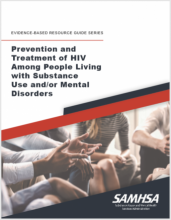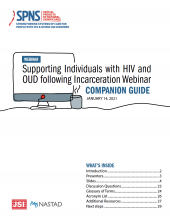
This guide offers considerations for how state agency staff can develop and maintain an accessible, HIV and opioid use disorder (OUD) service inventory. This guide can be used by state agency HIV and OUD staff to:



This guide offers considerations for how state agency staff can develop and maintain an accessible, HIV and opioid use disorder (OUD) service inventory. This guide can be used by state agency HIV and OUD staff to:
The growing opioid crisis across the United States has resulted in an increase in new HIV diagnoses.
Individuals who have HIV who also use drugs experience increased age-matched morbidity and mortality in comparison with those with HIV who do not use drugs.
This CDC report provides updated data related to HIV prevalence among people who inject drugs, documenting findings that underscore the need for low-barrier access to comprehensive and integrated needs-based syringe service programs for necessary prevention and
This PowerPoint slide deck reviews the foundations of harm reduction philosophy and practice, summarizes drug user health issues and trends, and aims to increase cultural competence and humility when working with people who use drugs.
This newly released national strategy confronts the rising rates of opioid and non-opioid related fatal overdoses.
This document describes the critical role that peers have in developing and delivering care for people with HIV and OUD and how a state’s Medicaid program can serve as an essential fiscal resource in supporting peer services.
This tool aims to assist HIV primary care teams that work in a range of clinical settings to develop and provide enhanced integration of behavioral health (BH) services.
This discussion guide is intended to elicit a comprehensive and concrete conversation about language, stigma, and discrimination as a means of strengthening care systems and ensuring that people who seek care for HIV and/or substance use disorders, including opioid use disorder, are treated with
This ready-to-use training package is designed to provide HIV providers (including physicians, dentists, nurses, therapists, social workers, counselors, specialists, and case managers) with an overview of the challenges and strategies for change in working with